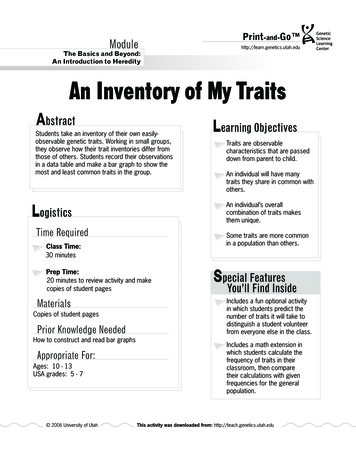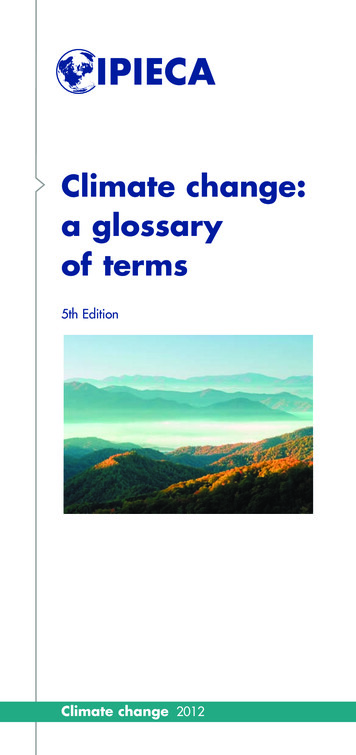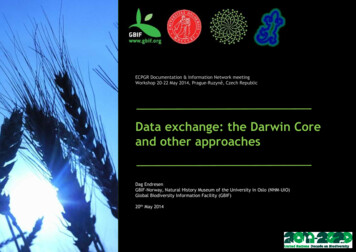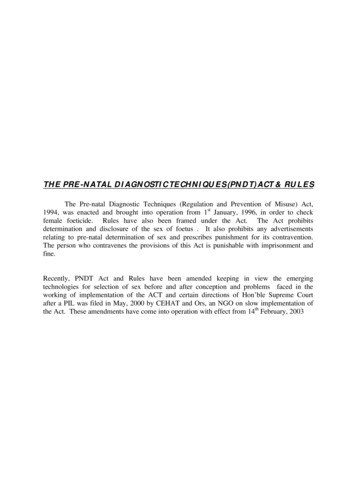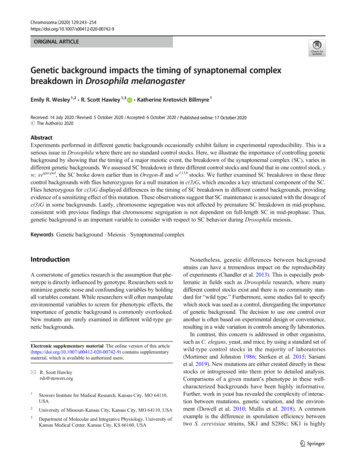
Transcription
Chromosoma (2020) 742-9ORIGINAL ARTICLEGenetic background impacts the timing of synaptonemal complexbreakdown in Drosophila melanogasterEmily R. Wesley 1,2 & R. Scott Hawley 1,3&Katherine Kretovich Billmyre 1Received: 14 July 2020 / Revised: 5 October 2020 / Accepted: 6 October 2020 / Published online: 17 October 2020# The Author(s) 2020AbstractExperiments performed in different genetic backgrounds occasionally exhibit failure in experimental reproducibility. This is aserious issue in Drosophila where there are no standard control stocks. Here, we illustrate the importance of controlling geneticbackground by showing that the timing of a major meiotic event, the breakdown of the synaptonemal complex (SC), varies indifferent genetic backgrounds. We assessed SC breakdown in three different control stocks and found that in one control stock, yw; svspa-pol, the SC broke down earlier than in Oregon-R and w1118 stocks. We further examined SC breakdown in these threecontrol backgrounds with flies heterozygous for a null mutation in c(3)G, which encodes a key structural component of the SC.Flies heterozygous for c(3)G displayed differences in the timing of SC breakdown in different control backgrounds, providingevidence of a sensitizing effect of this mutation. These observations suggest that SC maintenance is associated with the dosage ofc(3)G in some backgrounds. Lastly, chromosome segregation was not affected by premature SC breakdown in mid-prophase,consistent with previous findings that chromosome segregation is not dependent on full-length SC in mid-prophase. Thus,genetic background is an important variable to consider with respect to SC behavior during Drosophila meiosis.Keywords Genetic background . Meiosis . Synaptonemal complexIntroductionA cornerstone of genetics research is the assumption that phenotype is directly influenced by genotype. Researchers seek tominimize genetic noise and confounding variables by holdingall variables constant. While researchers will often manipulateenvironmental variables to screen for phenotypic effects, theimportance of genetic background is commonly overlooked.New mutants are rarely examined in different wild-type genetic backgrounds.Electronic supplementary material The online version of this ) contains supplementarymaterial, which is available to authorized users.* R. Scott Hawleyrsh@stowers.org1Stowers Institute for Medical Research, Kansas City, MO 64110,USA2University of Missouri-Kansas City, Kansas City, MO 64110, USA3Department of Molecular and Integrative Physiology, University ofKansas Medical Center, Kansas City, KS 66160, USANonetheless, genetic differences between backgroundstrains can have a tremendous impact on the reproducibilityof experiments (Chandler et al. 2013). This is especially problematic in fields such as Drosophila research, where manydifferent control stocks exist and there is no community standard for “wild type.” Furthermore, some studies fail to specifywhich stock was used as a control, disregarding the importanceof genetic background. The decision to use one control overanother is often based on experimental design or convenience,resulting in a wide variation in controls among fly laboratories.In contrast, this concern is addressed in other organisms,such as C. elegans, yeast, and mice, by using a standard set ofwild-type control stocks in the majority of laboratories(Mortimer and Johnston 1986; Sterken et al. 2015; Sarsaniet al. 2019). New mutations are either created directly in thesestocks or introgressed into them prior to detailed analysis.Comparisons of a given mutant’s phenotype in these wellcharacterized backgrounds have been highly informative.Further, work in yeast has revealed the complexity of interaction between mutations, genetic variation, and the environment (Dowell et al. 2010; Mullis et al. 2018). A commonexample is the difference in sporulation efficiency betweentwo S. cerevisiae strains, SK1 and S288c; SK1 is highly
244Chromosoma (2020) 129:243–254efficient at sporulation while S288c is not (Keeney 2009).Lastly, the mouse community has long been interested in theinfluence of genetic variation on phenotype and has madegreat strides in showing the necessity of examining phenotypes in multiple genetic backgrounds (Doetschman 2009;Justice and Dhillon 2016; Sittig et al. 2016).On the other hand, there are numerous examples inDrosophila in which a mutant exhibited different phenotypesin different genetic backgrounds. For example, the Indy mutant lengthens lifespan in Drosophila (Rogina et al. 2000).However, further examination in other genetic backgroundsrevealed that this phenotype was likely due to genetic background effects, rather than a specific mutation (Toivonen et al.2007). Similarly, the scalloped (E3) mutation displays markedly different phenotypes in the wild-type stocks Samarkandand Oregon-R (Dworkin et al. 2009). Genetic backgroundcomparison can also be used as a tool to learn more aboutthe function of a gene. For example, comparing the phenotypeof mushroom body miniature mutants in different geneticbackgrounds allowed the elucidation of two different rolesfor the gene: brain anatomy and associated olfactory learning(De Belle and Heisenberg 1996). Unfortunately, such comparisons are by no means standard in Drosophila genetics.Genetic background appears to be more important for phenotypes that cause intermediate effects than it is for thosephenotypes that have either weak or severe effects (Chandleret al. 2017). We focus here on the timing of synaptonemalcomplex (SC) breakdown, a variable phenotype of interestto our laboratory. The SC is a large tripartite protein structureformed between homologous chromosomes in meiotic prophase. It is required to both maintain chromosome pairingand for the formation of crossovers (reviewed in Cahoonand Hawley 2016). The SC is a highly conserved structurethat is composed of lateral and central elements with a centralregion containing a transverse filament protein that connectsthe two homologous chromosomes. In Drosophila, the centralregion of the SC contains two proteins, Corona (Cona) andCorolla, in addition to the transverse filament protein, C(3)G(Page and Hawley 2001; Page et al. 2008; Collins et al. 2014).If any component of the central region is absent, the SC doesnot form, which results in a lapse of chromosome pairing anda complete loss of genetic exchange. The absence of exchangecauses high levels of chromosome missegregation at meiosis I(Page and Hawley 2001; Page et al. 2008; Collins et al. 2014).The SC is fully assembled by early prophase (region 2A;Fig. 1). The SC remains fully assembled throughout earlyprophase and most of mid-prophase (stages 1–6) during whichDSBs are induced and designated as either non-crossovers orcrossovers (Page and Hawley 2001).In Drosophila, SC disassembly is said to begin at the end ofmid-prophase (stages 5–7; Fig. 1) (Page and Hawley 2001;Takeo et al. 2011) and conclude by mid/late prophase (stage7–9; Fig. 1). The impact of genetic variation on the timing ofSC breakdown has not been examined, and few studies existin which mutants exhibit premature SC breakdown (Webberet al. 2004; Billmyre et al. 2019). Furthermore, the mutants inthose studies were compared to genetically similar backgrounds to minimize genetic diversity. Historically, it hasbeen impossible to study SC breakdown/disassembly becausea mutation in any central region gene causes a complete loss ofthe SC. Therefore, little is known about the mechanisms thatregulate SC maintenance and disassembly.Here we report that genetic background of Drosophilamelanogaster affects the timing of SC breakdown. The threePROPHASE IEARLY/MIDMID PROPHASE IEARLYREGION 2A REGION 2B REGION 3/STAGE 1SC formation DSB initiationbeginsFull-length SC maintainedMID/LATESC disassemblyCentromeresFig. 1 Model of oocyte development in the Drosophila ovariole. SC(purple) formation begins in multiple nuclei during early prophase (region2A). DSBs (black) are formed and some are resolved into crossoversduring early to mid-prophase (region 2A to stage 1). By mid-prophaseDSBSC(stage 1), one cell is designated as the oocyte while the surrounding cellsbecome nurse cells. Full-length SC persists into mid prophase (stage 1through stage 5) and then begins disassembly from the chromosome armsin mid to late prophase (stage 5–7)
Chromosoma (2020) 129:243–254245wild-type stocks examined were y w; svspa-pol, Oregon-R(OreR), and w1118, which have been previously used as controls in many studies examining meiotic processes (Page andHawley 2001; Resnick et al. 2009; Takeo et al. 2011; Hugheset al. 2019; Billmyre et al. 2019). We found that the y w; svspapolstock exhibited SC breakdown significantly earlier thanOreR and w1118. Additionally, flies that are heterozygous fora null allele of c(3)G displayed even earlier breakdown of theSC in the y w; svspa-pol background, revealing a sensitizingeffect of heterozygosity for c(3)G. Surprisingly, the y w; svspa-polbackground acted as a c(3)G-specific dominant enhancer, as flies heterozygous for a corolla null allele did not exhibitthe premature SC breakdown phenotype. This work highlightsthe complex role that genetic background can have on meioticprocesses in Drosophila, supports previous work suggestingthat background can affect reproducibility, and is evidence ofa dosage effect of c(3)G in certain backgrounds.ResultsVariation occurs in the timing of SC breakdown inDrosophila control stocksSC assembly and maintenance is a highly regulated processthat ensures the proper alignment of chromosomes for successful recombination and segregation (reviewed in Cahoonand Hawley 2016). Failing to assemble full-length SC or premature disassembly of the SC results in recombination andpairing defects (Page and Hawley 2001; Manheim andMcKim 2003; Webber et al. 2004; Page et al. 2008; Collinset al. 2014; Billmyre et al. 2019). It is currently unknown whatregulates either assembly (See Hughes et al. 2019), maintenance, or disassembly of the SC.To explore the role that genetic background may play in theregulation of SC breakdown in Drosophila females, we askedwhether timing of SC breakdown was consistent among thethree control stocks commonly used for examining meioticmutants. These control stocks (y w; svspa-pol, OreR, andw1118) were stained with an antibody recognizing the centralelement protein, Corolla, to determine the median stage ofeuchromatic SC breakdown (See methods, Fig. S1). Thetiming of SC breakdown was assessed based on egg chambermorphology as previously described (Spradling 1993).Because mid-prophase extends throughout many stages ofdevelopment (stage 1–7), in this paper, we will reference thedevelopmental time point using the more specific term ofstage numbers (Fig. 1). The median stage of SC breakdownobserved in y w; svspa-pol was stage 4; however, the stage ofSC breakdown varied widely in y w; svspa-pol flies from stage 1to stage 8 (Fig. 2). This was significantly different than themedian stage of breakdown observed in OreR females (Fig. 2:stage 8, Range: stage 4–9, p 0.0007) and w1118 (Fig. 2: stageFig. 2 Timing of SC breakdown in Drosophila control stocks. a Maxprojections of representative oocytes stained with an antibody againstCorolla in the control stocks y w; svspa-pol, OreR, and w1118 throughoutmid-prophase (stage 1–7) (Scale bars, 2 μm). The SC is fragmented in yw; svspa-pol during stage 5–7. A haze of Corolla is normally present as theSC is breaking down. b Quantification of the stage of SC breakdown inthe control stocks y w; svspa-pol, OreR, and w1118 from mid-prophase(stage 1) to mid-/late prophase (stage 8–9). ** p 0.001 by Mann–Whitney U test. y w; svspa-pol: n 17; OreR: n 16; w1118: n 168, Range: stage 6–9, p 0.0004). The ranges of SC breakdown seen in OreR and w1118 stocks are consistent with previously published results (Page and Hawley 2001; Takeo et al.2011). The difference in SC breakdown observed between they w; svspa-pol, OreR, and w1118 control stocks suggests a possible relationship between genetic background and the timingof SC breakdown.c(3)G heterozygotes displayed premature SCbreakdown in the y w; svspa-pol control backgroundNext, we investigated whether heterozygotes carrying a singlecopy of a null allele of c(3)G would exacerbate the SC breakdown phenotype observed in the y w; svspa-pol background.The c(3)G gene encodes a transverse filament protein thatspans the width of the SC and is essential for SC formation(Page and Hawley 2001). Heterozygosity for a c(3)G nullallele might be expected to decrease the level of C(3)G protein. We reasoned that reducing the dosage of c(3)G may
246Chromosoma (2020) 129:243–254exacerbate the effect on SC breakdown observed in the y w;svspa-pol background. We examined SC disassembly in thepresence of heterozygosity for either of two null alleles ofc(3)G (c(3)G1 and c(3)G68). Specifically, c(3)G68 contains atruncating SNP while c(3)G1 has a spontaneous insertionalmutation (Page and Hawley 2001). Previous work withc(3)G68 heterozygotes found no changes in recombinationcompared to wild-type controls (Miller 2020). However,c(3)G1 heterozygotes have been reported to exhibit increasedrecombination in some genetic intervals (Hinton 1966; Meyeret al. 2014). It is also possible that this variation in recombination phenotype may be the effect of minor variations ingenetic background: Hinton assessed X chromosome recombination using different multiply marked X chromosomes andshowed that recombination was not consistently altered inc(3)G1 heterozygotes compared to controls when different Xchromosomes were tested (Hinton 1966).Both null alleles of c(3)G were used to create heterozygotesin each control background (y w; svspa-pol, OreR, and w1118), toensure that the phenotype was not due to a specific null alleleof c(3)G (Crosses diagrammed in Fig. S2; full genotypes inTable 1 and methods). Due to the c(3)G heterozygotes onlycontaining half the genetic material of the control stocks (seeFig. S2), we cannot directly compare SC breakdown in thec(3)G heterozygotes to the control stocks. Instead, we arelimited to comparing SC breakdown in c(3)G heterozygotesintroduced into different control backgrounds.The y w; svspa-pol background appears to expedite SCbreakdown in heterozygotes for both c(3)G alleles tested(Fig. 3). SC breakdown in y w; svspa-pol c(3)G heterozygoteswas significantly earlier when compared to w1118 and OreRc(3)G heterozygotes (Fig. 3). y w; svspa-pol c(3)G68 heterozygotes exhibited breakdown at stage 2, while SC in w1118c(3)G68 and OreR c(3)G68 heterozygotes broke down significantly later at stage 6 and 7, respectively (Fig. 3, p 0.0005,p 0.00001). Similar trends were apparent in c(3)G1 heterozygotes. We observed accelerated SC breakdown in y w; svspapolc(3)G1 heterozygotes when compared to w1118 c(3)G1 heterozygotes (Fig. 3, y w; svspa-pol c(3)G1 hets: stage 2 versusw1118 c(3)G1 hets: stage 7, p .00001). Although OreRc(3)G1 heterozygotes lost SC earlier than OreR c(3)G68Table 1 Full genotypes of c(3)Gand corolla heterozygotesheterozygotes at stage 5 compared to stage 7 (Fig. 3, p 0.002), breakdown in OreR c(3)G1 heterozygotes was not asearly as in y w; svspa-pol c(3)G1 heterozygotes (Fig. 3, stage 5versus stage 2, p 0.0001).Collectively, these observations reveal that c(3)G heterozygotes in a y w; svspa-pol background have significantly expedited SC breakdown when compared to OreR and w1118c(3)G heterozygotes. This is similar to the trend observedwhen comparing SC breakdown in control stocks (y w; svspa-pol, OreR, and w1118), and thus, the y w; svspa-pol background appears to expedite SC breakdown in both c(3)G and c(3)G/ heterozygotes (Figs. 2 and 3). The phenotypicsimilarity between the two c(3)G mutants strongly suggeststhe presence of a background modifier of C(3)G in the y w;svspa-pol stock, as the two mutants contain very different mutations within c(3)G and have been maintained in differentbackgrounds (Fig. S2).corolla heterozygotes do not have an SC breakdowndefect in the y w; svspa-pol backgroundWe next analyzed if the early SC breakdown in c(3)G heterozygotes in a y w; svspa-pol background was specific to c(3)Gmutants, or might also be observed in flies heterozygous formutations in genes encoding other SC components. If the y w;svspa-pol genetic background was affecting the entire SC structure, then perhaps heterozygosity for null alleles of genesencoding other SC components would affect SC perdurancein a similar fashion to c(3)G heterozygosity. As noted above,the corolla gene encodes another central region component ofthe SC. Heterozygotes for a null allele of corolla (corolla39)were examined in the y w; svspa-pol background by crossing yw; svspa-pol flies to a stock containing a corolla39 allele toproduce y w; sv spa-pol corolla 39 heterozygotes (Crossdiagramed in Fig. S2; full genotype in Table 1 andmethods). During the assessment of the y w; svspa-pol corolla39heterozygotes, we repeated an analysis of the y w; svspa-polcontrol stock in order to verify the median and range of thestage of breakdown. Premature SC breakdown was not observed in corolla39 heterozygotes in a y w; svspa-pol background (Fig. 4; stage 8, Range: stage 6–9). Indeed, SCGenotypeAbbreviated genotypey w/y; / ; th c(3)G68/ ; svspa-pol/ y w/ ; / ; ru h th st c(3)G1 es ca/ ; svspa-pol/ (OreR)/y; / ; th c(3)G68/ ; / (OreR)/ ; / ; ru h th st c(3)G1 es ca/ ; / w1118/y; / ; th c(3)G68/ ; / w1118/ ; / ; ru h th st c(3)G1 es ca/ ; / y w/y sc w cv v corolla39; / ; / ; svspa-pol/ y w; svspa-pol c(3)G68 heterozygotey w; svspa-pol c(3)G1 heterozygoteOreR c(3)G68 heterozygoteOreR c(3)G1 heterozygotew1118 c(3)G68 heterozygotew1118 c(3)G1 heterozygotey w; svspa-pol corolla39 heterozygote
Chromosoma (2020) 129:243–2542473 SC breakdown is accelerated in c(3)G heterozygotes in a y w; Fig.spa-polbackground. a Max projections of representative oocytessvstained with an antibody against Corolla in y w; svspa-pol c(3)G1 andc(3)G68 heterozygotes, OreR c(3)G1 and c(3)G68 heterozygotes, andw1118 c(3)G1 and c(3)G68 heterozygotes throughout mid-prophase (stage1–7) (Scale bars, 2 μm). The SC is fragmented in y w; svspa-pol c(3)G1 andc(3)G68 heterozygotes during stage 2–4. The SC is diffuse in y w; svspa-polc(3)G1 and c(3)G68 heterozygotes during stage 5–7. The SC is punctate inw1118 c(3)G68 heterozygotes during stage 5–7. The SC is fragmented inw1118 c(3)G1, OreR c(3)G1 and c(3)G68 heterozygotes during stage 5–7.B) Quantification of the stage of SC breakdown in y w; svspa-pol c(3)G1and c(3)G68 heterozygotes, OreR c(3)G1 and c(3)G68 heterozygotes, andw1118 c(3)G1 and c(3)G68 heterozygotes from mid-prophase (stage 1) tomid-/late prophase (stage 8–9). SC breakdown in y w; svspa-pol c(3)G68heterozygotes is significantly earlier when compared to w1118 c(3)G1heterozygotes (p 0.0001) and OreR c(3)G1 heterozygotes (p 0.014).However, the SC breaks down significantly later in w1118 c(3)G1 heterozygotes than in OreR c(3)G1 heterozygotes (p 0.0003). In y w; svspa-polc(3)G1 heterozygotes, the SC breaks down significantly earlier than inboth OreR c(3)G68 and w1118 c(3)G68 heterozygotes (p 0.00001).*p 0.01, **p 0.001, and ****p 0.00001 by Mann–Whitney U test.y w; svspa-pol c(3)G1 heterozygote: n 17; y w; svspa-pol c(3)G68 heterozygote: n 17; OreR c(3)G1 heterozygote: n 16; OreR c(3)G68 heterozygote: n 16; w1118 c(3)G1 heterozygote: n 17; w1118 c(3)G68 heterozygote: n 15in y w; sv spa-pol c(3)G heterozygotes (Fig. 3, stage 2,p .00001). Our observations suggest that premature SCbreakdown is not a general phenotype of flies heterozygousfor mutations in SC genes, but rather it appears to be specificto c(3)G heterozygotes in a y w; svspa-pol background.The y w; svspa-pol control stock does not containmutations in the coding sequence of c(3)Gbreakdown was significantly later than the median stage ofbreakdown in the y w; svspa-pol control stock (stage 4,Range: stage 1–9, p 0.008). The y w; svspa-pol corolla39 heterozygotes trended toward the wild-type timing of SC breakdown (Fig. 4) seen in OreR and w1118 control stocks (compareto Fig. 2). Additionally, the timing of SC breakdown in y w;svspa-pol corolla39 heterozygotes was significantly differentwhen compared to the median stage of breakdown observedOne possible explanation for the different phenotypes incontrol backgrounds is that weak mutations in genesencoding SC proteins were present in y w; svspa-pol butnot OreR and w1118 backgrounds. Such mutations couldresult in reduced levels of C(3)G and a greater acceleration in SC breakdown when one c(3)G null allele waspresent. Using Sanger sequencing, the c(3)G genes ofthe three control stocks (y w; svspa-pol, OreR, and w1118)were compared to the reference genome (ISO-1)(Thurmond et al. 2018). No coding changes were identified in c(3)G when comparing the control stocks to eachother (Table 2). However, 11 SNPs were present outsideof the coding region of the c(3)G gene in the OreR andw1118 control stocks when compared to the reference genome and y w; svspa-pol sequence (Table 2). Seven of theseSNPs were located within the 3’ UTR of c(3)G, two werelocated directly downstream of the gene, and two werelocated approximately 800 and 1100 base pairs upstreamof c(3)G. Additionally, the presence of a mutation in amodifier or enhancer region outside of c(3)G in y w; svspa-polflies cannot be ruled out.
248Chromosoma (2020) 129:243–254Fig. 4 corolla 39 heterozygotes do not display altered timing ofbreakdown. a Max projections of representative oocytes stained with anantibody against Corolla in y w; svspa-pol and y w; svspa-pol corolla39heterozygotes from mid-prophase (stage 1–7) to mid-/late prophase (stage8–9) (Scale bars, 2 μm). The SC is fragmented in y w; svspa-pol duringstage 2–4, stage 5–7, and stage 8–9. The SC is fragmented in y w; svspa-polcorolla39 heterozygotes during stage 8–9. B) Quantification of stage ofTable 2w1118Differences between c(3)G in ISO-1, y w; svspa-pol, OreR, andISO-1y w; svspa-polOreR and w1118LocationGGADownstream of geneGGACAGATATGAGNot presentGAGGACAGATATGAGNot presentGAACTTNot presentTCTATAGDownstream of gene3’ UTR3’ UTR3’ UTR3’ UTR3’ UTR3’ UTR3’ UTR800 bp upstream1100 bp upstreamSNPs from 2015 bp upstream, 473 bp downstream, and within the c(3)Ggene of y w; svspa-pol that differ from c(3)G in OreR and w1118 . There areno coding changes in the c(3)G gene in y w; svspa-pol when compared toOreR and w1118 . Sequencing results were generated using Sanger sequencing and primers listed in Key Resource Table. ISO-1 sequence isfrom the reference sequence (FB2020 02) available on FlyBase(Thurmond et al. 2018)SC breakdown in the control stock y w; svspa-pol and y w; svspa-polcorolla39 heterozygotes from mid-prophase (stage 1) to mid-/late prophase (stage 8–9). *P 0.01 by Mann–Whitney U test. y w; svspa-pol:n 10; y w; svspa-pol corolla39 heterozygote: n 18. The median stageof breakdown in y w; svspa-pol corolla39 heterozygotes (stage 8) trendstoward that seen in the OreR and w1118 control stocks (stage 8)Many germline genes are regulated by the 3’ UTR (Merrittet al. 2008), so it is possible that these SNPs are regulating SCbreakdown. This has not been extensively studied inDrosophila. We used qPCR to test if c(3)G RNA levels differed in y w; svspa-pol ovaries compared to OreR, and w1118ovaries in both c(3)G 1 and c(3)G 6 8 heterozygotes.Interestingly, c(3)G RNA expression in the y w; svspa-pol controls was less than half of that in OreR, and w1118 (Fig. S3),suggesting the y w; svspa-pol ovaries contained less c(3)GRNA. However, c(3)G1 heterozygotes in all control backgrounds had significantly less c(3)G expression than OreR,and w 1118 control backgrounds (Fig. S3), even thoughc(3)G1 OreR and w1118 heterozygotes do not exhibit the samepremature SC loss. This suggests that decreased c(3)G RNAexpression is not sufficient to cause premature SC loss andthat the phenotype observed in the y w; svspa-pol background ismore complex than simply reducing expression of c(3)G. Incontrast, y w; svspa-pol c(3)G68 heterozygotes exhibit relativelynormal levels of expression and still exhibit premature SCbreakdown in the y w; svspa-pol background.Surprisingly, expression of c(3)G RNA in c(3)G1 heterozygotes in all tested backgrounds was less than in c(3)G68heterozygotes (Fig. S3). Both the c(3)G1 and the c(3)G68 mutations cause premature stop codons, but the large transposon
Chromosoma (2020) 129:243–254249insertion present in the c(3)G1 allele could reduce levels ofc(3)G transcription or alter the stability of the c(3)G1 transcript. In many systems, transposons have been found to inactivate or alter gene expression when inserted within genes orin nearby regulatory regions (Kazazian 2004; Munoz-Lopezand Garcia-Perez 2010). In Drosophila, a particularly niceexample of this comes from attempts to identify a causativemutation after a screen. In this case, the gene responsible forthe phenotype, ald, did not have a mutagenic lesion but instead a Doc transposable element in a neighboring gene suppressed the function of ald in cis in the germline, but not in thesoma (Hawley and Gilliland 2006). It is likely that differencesin gene expression between c(3)G1 and the c(3)G68 heterozygotes are due to the presence of a transposon in the first exonof c(3)G in the c(3)G1 allele.Because Corolla is also a necessary component of the SC(Collins et al. 2014), corolla was sequenced from the 500 bpregions upstream to downstream of corolla in each of thecontrol stocks. Only one SNP was present within the codingregion of corolla in y w; svspa-pol when compared to OreR orw1118. This guanine-to-thymine point mutation would result inan amino acid change from aspartate to glutamate at position454 in Corolla. Because of the minimal structural differencebetween aspartate and glutamate, this SNP is likely notsignificant.Premature loss of SC does not disrupt chromosomesegregationTo determine if the premature SC breakdown in y w; svspa-polc(3)G heterozygotes affected meiotic outcomes, chromosomesegregation was assessed. The y w; svspa-pol control stockdisplayed negligible rates of X (0.7%) and 4th (0.3%) chromosome nondisjunction (Table 3: adj. N 585), consistentwith previously published results (Hughes et al. 2019;Billmyre et al. 2019). y w; svspa-pol c(3)G68 heterozygotesphenocopied these results with nondisjunction rates of 0.0%DiscussionHere we show that timing of SC breakdown in c(3)G heterozygotes is susceptible to the effects of genetic background.Specifically, a y w; svspa-pol background significantly accelerated SC breakdown in c(3)G heterozygotes compared to OreRand w1118 backgrounds (Figs. 2,3). A lesser effect on SCbreakdown timing was observed in the y w; svspa-pol controlstock in the absence of c(3)G heterozygosity. By examiningSC breakdown in corolla39 heterozygotes in the y w; svspa-polbackground, we confirmed that the breakdown phenotype isspecific to both the y w; svspa-pol stock and y w; svspa-pol c(3)Gheterozygotes. Additionally, our analysis of chromosome segregation showed that the premature breakdown of full-lengthSC early in mid-prophase (stage 2) was not sufficient to causechromosome missegregation.Control backgrounds in Drosophila409Many fields have standard control stocks, such as N2 inCaeno rhabd itis e le gans , and SK1 and S288 c inS. cerevisiae. However, in Drosophila, multiple control stocksare used depending on the laboratory and the experimentalapproach. Worse yet, the genetic identity of so-called controlstocks can vary from lab to lab. Even if different labs are usingstocks with the same known mutations as controls, they mayhave been maintained separately for decades. Due to the artificial population bottleneck, this can lead to an accumulationof mutations or modifiers; some of which may modify mutantphenotypes. The use of varying control stocks can lead toreproducibility issues between laboratories, thus highlightingthe importance of genetic background in experiments.0.0 (p 0.196)0.7 (p 0.536)Why does the y w; svspa-pol background causepremature SC breakdown in c(3)G heterozygotes?Table 3 Premature loss of SC does not impact the rate of X and 4thchromosome nondisjunction in y w; svspa-pol and c(3)G heterozygousfemalesMaternal genotype y w; svspa-pol y w/y; / ; th c(3)G68/ ; svspa-pol/ Adjusted N value 585Percent nondisjunction (p value)X0.74th0.3(p 0.196) and 0.7% (p 0.536) for the X and 4th chromosome, respectively (Table 3: adj. N 409). Nondisjunctionrates of the X chromosome and the 4th chromosome werenot significantly different between the y w; svspa-pol controlstock and y w; svspa-pol c(3)G68 heterozygotes (Table 3).These rates of nondisjunction differ from the large amountof X chromosome (39.2%) and 4th chromosome (26.8%)missegregation seen in c(3)G68 homozygotes (Hall 1972).The wild-type levels of nondisjunction observed in y w; svspa-polc(3)G heterozygotes indicate that premature SC breakdown at stage 2 does not result in the missegregation ofchromosomes.Calculations performed as described in the methods (Zitron and Hawley1989; Hawley et al. 1992). Adjusted N accounts for the inviable progenyclass plus the scored progeny. Significance calculated as previously described (Zeng et al. 2010)The control stock, y w; svspa-pol, is often used for chromosomesegregation studies because of the utility of the phenotypicmarkers present. The y and w mutant alleles are used to assay
250both gain and loss of the X chromosome, while the svspa-polallele is used to test for 4th chromosome nondisjunction. The yw; svspa-pol stock used in this study was created in the Hawleylab in 2009 and has been passaged by serial transfer sincethen, potentially allowing for modifiers to accumulate.Perhaps one explanation of our da
* R. Scott Hawley rsh@stowers.org 1 Stowers Institute for Medical Research, Kansas City, MO 64110, USA 2 University of Missouri-Kansas City, Kansas City, MO 64110, USA 3 Department of Molecular and Integrative Physiology, University of Kansas Medical Center, Kansas City, KS 66160, USA


